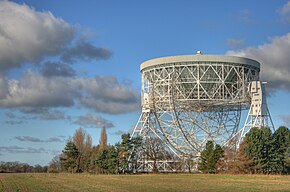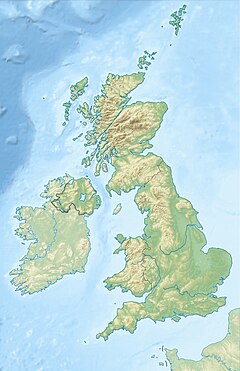
Back مرصد جودريل بنك Arabic مرصد جودريل بانك ARZ Observatori de Jodrell Bank Catalan Observatoř Jodrell Bank Czech Jodrell-Bank-Radioobservatorium German Observatorio Jodrell Bank Spanish Jodrell Banki observatoorium Estonian رصدخانه جودرل بانک Persian Observatoire de Jodrell Bank French Jodrell Bank Irish
 | |
| Alternative names | Jodrell Bank Experimental Station |
|---|---|
| Named after | William Jauderell |
| Organization | |
| Location | Lower Withington, Cheshire East, Cheshire, North West England, England |
| Coordinates | 53°14′10″N 2°18′26″W / 53.23625°N 2.3071388888889°W |
| Altitude | 77 m (253 ft) |
| Established | 1945 |
| Website | www |
| Telescopes |
|
| | |
| Location | Cheshire, England |
| Criteria | Cultural: (i), (ii), (iv), (vi) |
| Reference | 1594 |
| Inscription | 2019 (43rd Session) |
| Area | 17.38 ha (42.9 acres) |
| Buffer zone | 18,569.22 ha (45,885.5 acres) |
Jodrell Bank Observatory (/ˈdʒɒdrəl/ JOD-rəl) in Cheshire, England hosts a number of radio telescopes as part of the Jodrell Bank Centre for Astrophysics at the University of Manchester. The observatory was established in 1945 by Bernard Lovell, a radio astronomer at the university, to investigate cosmic rays after his work on radar in the Second World War. It has since played an important role in the research of meteoroids, quasars, pulsars, masers, and gravitational lenses, and was heavily involved with the tracking of space probes at the start of the Space Age.
The main telescope at the observatory is the Lovell Telescope. Its diameter of 250 ft (76 m) makes it the third largest steerable radio telescope in the world. There are three other active telescopes at the observatory; the Mark II and 42 ft (13 m) and 7 m diameter radio telescopes. Jodrell Bank Observatory is the base of the Multi-Element Radio Linked Interferometer Network (MERLIN), a National Facility run by the University of Manchester on behalf of the Science and Technology Facilities Council.
The Jodrell Bank Visitor Centre and an arboretum are in Lower Withington, and the Lovell Telescope and the observatory near Goostrey and Holmes Chapel. The observatory is reached from the A535. The Crewe to Manchester Line passes by the site, and Goostrey station is a short distance away. In 2019, the observatory became a UNESCO World Heritage Site.[1][2]
- ^ "Six cultural sites added to UNESCO's World Heritage List". UNESCO. 7 July 2019.
- ^ "Jodrell Bank gains Unesco World Heritage status". BBC News. 7 July 2019. Retrieved 7 July 2019.
